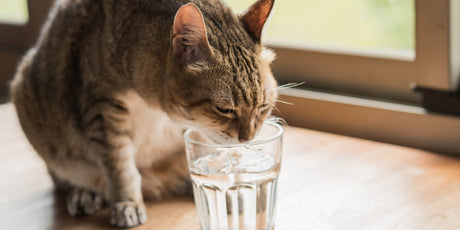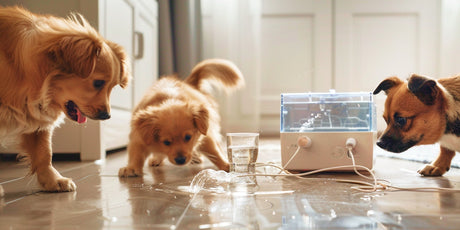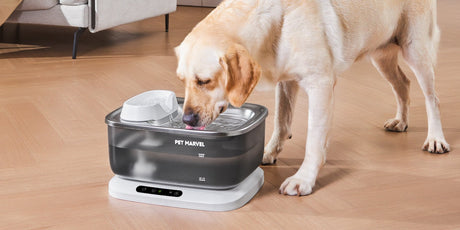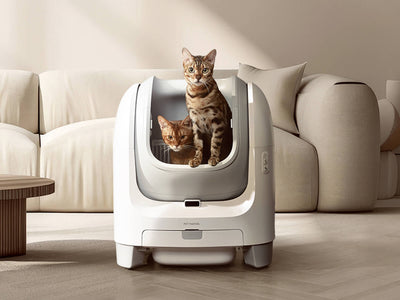This issue is not only about the size of the bowl, as it also depends on the size of your cat. Additionally, you will certainly be concerned about what material, shape, color, etc., are best for the bowl, as well as questions about pet automatic water dispensers. This article will help you find the answers.
1. Bowl Capacity
When choosing the size of the bowl, the first thing to consider is its capacity. In fact, it should be greater than your cat's daily water consumption. We can determine your cat's daily water intake through the following simple reference table.

Tips:Water requirements can vary due to climate, diet (dry food or wet food), and activity level.
For example, a typical American Shorthair cat may weigh around 10 lbs, and its recommended daily water intake is 300-400 ml (10-14 oz). Therefore, when choosing the size of the bowl, you should aim for a bowl that holds more than 400 ml. The reason for exceeding the recommended amount is that you must consider the evaporation rate during hot weather, and you should not underestimate how much water cats can waste.
2. Bowl Size
Once you have confirmed the capacity, many people do not pay attention to the specific dimensions (depth and diameter) of the bowl, which depends on whether you know what "Whisker Fatigue" is.
This term may sound strange, but it indeed exists in some cats, especially those with related health issues. A cat's whiskers are very sensitive and can detect even slight changes in airflow. If the whiskers constantly brush against objects, they can easily become fatigued. For example, if a cat's whiskers touch the sides of the food or water bowl, some cats become so sensitive that they refuse to eat from the bowl.
- Depth: It is generally recommended to choose a bowl with a depth not exceeding 5 cm (about 2 inches). This helps prevent the cat's whiskers from touching the rim of the bowl while drinking, which can cause discomfort.
- Diameter: The recommended diameter for the bowl is between 15-20 cm (about 6-8 inches); a wider bowl allows the cat to drink more comfortably. The depth here generally has universal reference value. If you want to get an accurate diameter, you can measure the length of the cat's longest whiskers on both sides. For growing kittens, you can refer to others' measurements or the reference values above.
The depth here generally has universal reference value. If you want to get an accurate diameter, you can measure the length of the cat's longest whiskers on both sides. For growing kittens, you can refer to others' measurements or the reference values above.
3. Bowl Material
The most recommended material remains stainless steel, followed by ceramic. This is true even if you are using a pet automatic water dispenser.
Stainless steel is widely used in daily life due to its durability and resistance to bacterial growth, and its price is comparable to or cheaper than ceramic. Ceramic, due to its unique material and safety, allows for more beautiful patterns to be printed, and its heavier weight ensures good stability; the only drawback is its fragility. For more details on materials and recommendations, you can refer to:
4. Bowl Color
Have you heard the rumor that black bowls can encourage your cat to drink more water? This is a complete myth, and black bowls can even have the opposite effect. Although there is currently no scientific evidence showing that the color of a bowl affects a cat's water intake, we can still debunk some myths by analyzing factors like vision, habits, and temperature.
Cats have limited sensitivity to color, and while black bowls can create a high contrast (making the boundary between the water and the bowl obvious), overly dark colors can mislead cats about the water level or quality. For example:
A black bowl might make clear water appear murky (similar to a shadow or dirty visual effect), causing the cat to be wary of "not fresh water."
In low-light environments, a black bowl may completely conceal the water level, preventing the cat from judging the amount of water and reducing its drinking.
Additionally, dark bowls (like black) absorb heat easily, which may raise the water temperature (especially in sunlight), while cats prefer cooler water sources.
There’s an interesting question: why doesn’t my cat like stainless steel bowls?
Although the issue is not related to color, the following characteristics may cause cats to reject them (explained by material factors beyond color):
Mirror Reflection: The reflective surface of stainless steel can create reflections or shadows; cats may feel nervous seeing their moving image or changes in ambient light, mistakenly believing there is a "threat" nearby.
Sensitivity to Dynamic Light Sources: Cats may feel a hunting impulse or unease towards quickly moving light spots (like reflections on a stainless steel bowl), interfering with their focus on drinking.
Texture and Temperature: The cold feel of metal: Stainless steel has strong thermal conductivity, so the bowl's wall temperature can be low in winter or air-conditioned environments, which may cause discomfort when the cat's whiskers or face touch it.
Residual Cleaners: If a stainless steel bowl is not thoroughly rinsed, the lingering scent of cleaning agents can become more pronounced, further reducing its appeal.
Noise from Collisions: Stainless steel bowls can make a crisp sound when colliding with the ground or the cat's collar tags, potentially startling sensitive individuals.
5. Number of Bowls
If your cat does not like to drink water and drinks infrequently, you might consider placing several bowls to reduce their effort in accessing water. You can also use a pet water dispenser, as running water can attract their interest in drinking. When you have multiple cats, providing at least one water bowl for each cat is a basic requirement.
6. Bowl Cleaning
If you have enough patience, washing their bowls daily can effectively prevent the growth of bacteria. If this is not feasible, it is necessary to clean the bowls at least once a week with a mild detergent. Additionally, you need to change the water daily, as cats are very particular about their water source.
7. Automatic Water Dispenser
Investing in an automatic water dispenser typically costs between $20 and $150. A dispenser around $20 can meet the drinking needs of one cat, but if you have multiple cats or dogs, you may incur higher expenses. Automatic water dispensers alleviate concerns about capacity, and the fountain design helps prevent whisker fatigue. Most importantly, the filter circulates and purifies the water, encouraging them to drink more often. However, cleaning an automatic water dispenser is not an easy task, as there may be some small components inside that can create hygiene blind spots. The PET MARVEL dog water dispenser is popular among many customers due to its simple design, and I believe it would also suit a multi-cat environment.
Conclusion
Choose the appropriate material, size, and number of water bowls based on your cat's size and quantity. If you suspect your cat is experiencing whisker fatigue that you haven't noticed, you might try bowls designed to prevent whisker fatigue. If your budget allows, an automatic water dispenser is also a good option.





